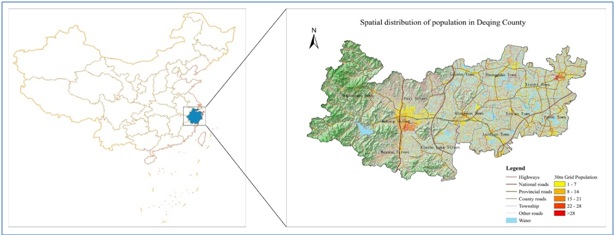Sustainable Deqing: Leveraging Economic and Social Progress with Transformation of Rural Environment: Deqing’s Experience in SDG Implementation
Description
The government of Deqing County has carried out a series of actions hat are socially inclusive, economically productive and environment-friendly, such as integrated management of water resources, environmentally-sound garbage disposal, etc. Some of the reforms and innovations prove to be quite successful at the local level, for example, in the township of Moganshan and its subordinate villages, which not only beautifies the rural residential areas, but also provides strong underpinnings for sustainable consumption and production, including eco-tourism and home-stay economy. The evidence-based progress has been achieved from 2013 to 2018, with great transformational impact brought about in the rural areas.
The practice specifically corresponds to the SDGs 1, 6, 8, 9, 12,15, and the corresponding targets: <br />
<br />
Objective 1: The new model of integration of urban and rural sustainable development through a stronger emphasis on environmental management aims to promote SDG 12 on sustainable consumption. The county put in place a unified strategy for waste management, including cleaning, collection, transportation, treatment and maintenance of urban and rural garbage, thus effectively improving the level of urban and rural environmental management. The county decided to realize this objective by 2017 in a phased manner - achieving rural domestic waste treatment rate by 100%; and achieving 100% village coverage rate of domestic waste separation(These goals have been achieved.)<br />
<br />
Objective 2: The County has placed renewed emphasis on the management of rural domestic sewage, addressing its treatment, operation and maintenance. This new policy aims to comprehensively solve the problems of low construction standards of rural domestic sewage treatment, low operating load, and inadequate operation mechanism of facilities, and to further accelerate integration of urban and rural infrastructure, and improve the quality of rural residential environment. The county sought to achieve, by 2016, rural sewage collection and treatment exceeding 80%.( The goal has been achieved.)<br />
<br />
Objective 3: The county established the working mechanism of “River/Lake Monitoring System", which aimed at continuously optimizing the quality of water environment. Under this mechanism, the county aimed to achieve by 2017, holistic elimination of class V water within the county; and by 2020,100% reaching class III or above of surface water quality in County level control .
Innovative Partnership: Science and technology are widely used, e.g., pipeline robots are used to patrol pipelines in mountainous areas, and unmanned aerial vehicles (UAVs) are used to patrol rivers. Non-governmental civil society groups are actively involved, including local villagers, business owners and other parties to participate as "Civic River Monitor".
1. The Rural Garbage Disposal. The local government of Deqing County started to implement the project of integration of urban and rural garbage disposal in 2009. Since 2014, the County has taken the national lead in this area by introducing a new model of integrated treatment of urban and rural wastes from county to village, which has been called "one broom sweeping to the end". Take Yaowu Village of Moganshan Town as an example: methods such front-to-end collection, classified delivery by farmers, etc. have been implemented as a pilot project. By the end of 2018, 276 households in the village were equipped with sorting bins and 5 public garbage sorting kiosks were built. Garbage was compressed to the terminal mode at a time for direct transportation twice a day to ensure garbage clearance every day. Terminal disposal is carried out at the county level by means of harmless incineration, power generation and resource utilization.
2. Rural water environment management. Of the operation and maintenance management of rural domestic sewage treatment, different sewage collection modes and technologies were adopted according to the location, population size, topography, hydrological characteristics, discharge requirements and economic level of the villages. As the practice was also implemented from county level to village level, it is known in the local area as “one pipe connecting to the bottom”. Specifically, Moganshan Town is located in the mountainous area, with less land available for construction, and villages are scattered around the mountainous area with very weak connection between each other and with the township as well in infrastructure. Therefore, wastewater treatment in this area is mainly decentralized, with an innovative technology of "anaerobic acidification pond + constructed wetland" . Take the Paitou area within the town for example, 31 sewage treatment construction terminals, and sewage treatment pipeline of altogether 29,800 meters long have been constructed in 5 administrative villages, connecting with 1467 households. Domestic sewage is centralized into grille sedimentation tank, and then into anaerobic tank. The pollutants are degraded by attaching facultative microorganisms with elastic packing film; and later the sewage is further degraded in the constructed wetland. After treatment, the water quality can reach the required standard, which can be used for recharge and gardening. This method makes full use of the oxygen transporting function of plant roots and has remarkable effect on the degradation and removal of organic matter and heavy metals. It also has the advantages of good heat preservation, resistance to climate impact and better sanitary conditions. However, the process control is relatively complex in the specific implementation process.
3. Strengthening water monitoring and management. The local government has implemented the mechanism of "River/Lake Monitoring System" since 2013. Moganshan Town, as the drinking water source protection area in the County, owns 43 rivers and 93 hill reservoirs, all of which have been appointed with "River/Lake Monitors", who have the responsibility of inspecting rivers and lakes at regular intervals, to guarantee their safety and well-preservation.
Local industry transformation accelerated. The county called for continuous improvement of rural environment, which has gradually transformed local industries with high pollution, high energy consumption and low output, fundamentally reshaping its industrial structure. By the end of 2018, 108 pig farms, 70 bamboo processing factories and 32 other enterprises that were sources of pollution in Moganshan Town were eliminated as part of the county drive for sustainable consumption and production patterns. In addition, the county began to promote cultural creativity and eco-tourism, attracting investments both domestically and internationally. For example, foreign investors have invested in disused farmhouses, factories, transforming them into resorts as “hill-stations”, using nature-friendly recycled materials. Driven by this high-end and low-carbon vacation industry, the eco-tourism and home-stay economy within Moganshan Town has risen rapidly. Take Laoling village for example, the home-stay houses increased from around 30 in 2013 to 87 by 2018. The New York Times has ranked Mogan Mountain as "one of the 45 places worth visiting in the world". In 2015, the residential accommodation of Moganshan style was exhibited at the World Expo in Milan. In 2018 only, 2.1 million tourists were received in the home-stay houses at Moganshan Town, accounting for 80.8% of the total number in the town, and the business income was RMB 2.05 billion yuan (approximately USD 304 million), accounting for 82% of the total tourism revenue in the town. Of the 720 residential houses registered, 431 are equipped with updated sewage treatment systems, and the rest are under county-unified management.
Local employment and income growth promoted. The eco-tourism and home-stay industry have promoted job creation, by offering jobs or self-employment opportunities to 15,000 local, villagers and farmers, accounting for 60.2% of the total number of employees in the township area. Among them, 82.6% were returned villagers who used to be migrant workers in big cities and came home to start their own businesses, which accounts for 83.40% of the total residential houses set up in the town. The average monthly stable income of villagers in residential employment is about RMB 4000 yuan (approximately USD 600). In addition, most of the vegetables, fruits and livestock needed for the operation of residential resorts come from villagers' farm production. Take Hecun Village for example, the eco-tourism and home-stay industry has brought about the sale of local products of about RMB 120 million yuan (approximately USD18 million) per year.
Constraints: First of all, as the area has attracted more and more tourists, the burden for waste disposal and garbage transportation has doubled or even tripled, which requires an ever increasing investment for the future sustainability of eco-tourism and sustainable consumption. Secondly, there remains the need for further enhancing the awareness of environmental protection and ecosystem health on the part of the villagers and tourists for the long-term preservation of the local environment and sustainable development of the multi-faceted eco-tourism model.
The "River/Lake Monitoring System" also has a high replicability. Deqing County has exchanged relevant work experience at the national level on many domestic occasions. The related national department has made a special survey of Deqing County in the implementation of the initiative and has awarded the Deqing County the recognition as a sustainable county, including as one of the top ten successful cases of grassroots water control in China for two consecutive years.
The "one pipe to the bottom", "one broom to the end" and "river/lake monitoring system" innovative practices have been cited in the United Nation’s "China (Deqing) Sample on Implementing the 2030 Agenda for Sustainable Development" , which has been released to the world during the inaugural United Nations World Geographic Information Conference in November, 2018.
The innovative practice in Deqing County, Zhejiang Province, China is an ongoing project of implementation of the 2030 Agenda and a project of sustainability in action, and it will continue. The County is more and more aware of the fact that optimizing the balance between economy, society and environment is at the heart of achieving the SDGs. It will have long-term impact on the ecological preservation, sustainable industry transformation and upgrading, and in particular, public and social well-being. The improvement of water quality from inferior to superior, the transformation of village landscape , the pursuit of eco-tourism and sustainable consumption, are part of an overall integrated strategy for improving environmental protection, meeting the people's growing needs for a better life without affecting the wellbeing for future generations, and sharing equally the benefits of high-quality sustainable development. As reflected in the local practice, the optimization of the rural environment through integrated waste management, eco-tourism and sustainable consumption has effectively reversed the unsustainable pattern of industrial production and fostered the upgrading and transformation of Moganshan Town. Deqing County has been working hard towards developing a harmonious coexistence between humans and nature, economic growth and social progress and environmental protection, while answering the call of United Nations 2030 Agenda and the SDGs.
English introduction:https://cn.nytimes.com/travel/20120929/c29fortyfive/
[2]Xinhua.net. UNWGIC 2018 held in China's Zhejiang[N]. November 19, 2018. http://m.china.org.cn/orgdoc/doc_1_29302_1058743.html
[3]环卫科技网,“一把扫帚扫到底”——德清县城乡环卫一体化管理新模式[N],2015年8月10日,http://www.cn-hw.net/html/china/201508/50424.html
[4]德清新闻网,“一根管子”接出水清村美[N],2015年3月30日,http://dqnews.zjol.com.cn/dqnews/system/2015/03/30/019176970.shtml
[5]浙江在线,第一批浙江省美丽乡村示范县:德清县[N],2016年09月30日,http://town.zjol.com.cn/system/2016/09/16/021300986.shtml
[6]中国改革报,浙江德清“河长制”走出科学治水新路子[N],2018年8月14日。
[7] 湖州发布,全国水利基层治水十大经验榜:德清又一个全国第一[N],2017年1月5日,http://www.sohu.com/a/123476089_434584
[8]新华网,微纪录:山里为何来了一位“洋河长”?2017年07月11日,http://www.xinhuanet.com/2017-07/11/c_129652477.htm
[9]womenofchina.cn, Hill Staition Industry Promotes Local Economy in Moganshan[N], E China, June 1, 2018, http://m.womenofchina.cn/xhtml/culture/lifestyle/18060059-1.htm.
[10]小镇莫干,走出国门!米兰世博会上,年轻教授把莫干山民宿带向了世界,2017-09-08,http://www.sohu.com/a/190824841_664510
[11]Chen Jun, Peng Shu, Ge Yuejing, et al. 2017 Deqing’s Progress Report on Implementing the 2030 Agenda for Sustainable Development: A Comprhensive Measurement with Statistical and Geospatial Information[R], 2018.
SDGS & Targets
Deliverables & Timeline
Resources mobilized
Partnership Progress
| Name | Description |
|---|
Feedback
Action Network


Timeline
Entity
Region
- Asia and Pacific
Geographical coverage
Photos


Website/More information
Countries

Contact Information
Juntao Wang, Staff
